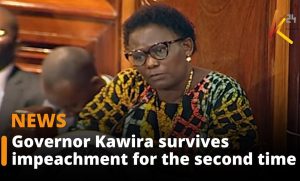October saw mass migration of television journalists to KTN which is under the new management raising questions about how their brand and the stations they work for
Every few years, a Tsunami happens in Kenyan newsrooms. Previously, you would tune to a television station and see a “new” face from a competing station. Then, it was a surprise. But times have changed if the last few weeks are anything to go by.
Courtesy of gossip blogs and websites, we now know well in advance which journalist is changing jobs as soon as he/she signs on the dotted line. Sometimes, the gossip goes ahead to reveal the journalist’s new pay. How times have changed.
As soon as hurricane Sandy was done with the United States in October, she decided to visit Kenyan newsrooms. In the last few weeks we have seen a mass migra-tion of television journalists to KTN which is under the new management of Sam Shollei. KTN has even recalled veteran news anchor Njoroge Mwaura who made his debut on Prime News on the night of Wednesday, 5 December 2012.
Kenyan television stations have realized they must offer quality news and this can only be delivered by journalists who are brands. Television stations are also brands and their choice of anchors is a strategy to grow and maintain viewership and increase advertising revenue. The latest Kenya Audience Research Foundation (KARF) data on advertising spend in quarter three of 2012 shows advertising revenue at KSh24 billion. Advertisers are now working with media personalities who are brands. For example Safaricom, one of the highest media advertisers, is using Dan Ndambuki as the face of some of its promotions.
Media as brands
A media brand like any other must stand for something. “They must have a clear big agenda beyond just making money. They must clearly define whom they wish to reach and remain consistent over the long term so as not to confuse the market or loyal followers,” says Tom Sitati, the Managing Partner of Brand Integrated Consulting. But the most important point in building a great brand according to Sitati is the fact that a brand must connect at an emotional level with its chosen audience.
In comparing the top global media brands, Sitati notes that what Kenyan media brands lack is a clear unabashed and unwavering big agenda that does not change depending on prevailing politics, economic climate, trends or passing fads. This he says calls for media houses to proactively create their brand equity. “Creating brand equity takes plenty of time. Human beings take time before they can fully trust a brand and therefore pay top dollar for a stake in it or pledge unreserved loyalty. They (media houses) must be clear on their big agenda and remain consistent for the long term.”
Some of the television journalists who have moved to KTN from NTV include John Alan Namu, Mohamed Ali, Joe Ageyo, and Linda Ogutu. Namu and Ali were previously at KTN where they distinguished themselves as investigative journalists. Ogutu has over the years grown at NTV to become a darling of viewers to the point that social media is active with comments about her when she is on air. She especially became popular during the NTV County Edition Series – an innovative strategy by NTV that devolved news reporting to the counties. That project, was driven by among others, Ageyo, who was a news editor. So what does their movement mean to the KTN and NTV brands? News anchors are often perceived as the face of a station, especially in Kenya where viewers are obsessed with news. “Such a move first creates confusion among the viewers but this will be short lived. It must be remembered that news anchors are present during a very limited period of the overall programming and so even as much as they dominate prime time, their influence could be overemphasized,” notes Sitati.
Additionally, on the brand and business front, the recent move by KTN gives the impression that KTN is on the up and up while NTV is perceived to be declining. “Losing your priced assets may mean you are unable to compensate them sufficiently to keep them or you are a proverbial house on fire that your priced assets are escaping from,” says Sitati.
Television programming
However, programming has a big role to play in the competition between television channels. Upon closer examination, you can tell there isn’t that much difference between all the big local television chan-nels. For private owned stations, Citizen TV set the pace in broadcasting a larger proportion than normal of local content. The others have since more or less caught up and are therefore not too far behind if you are mathematical about it. An example is Citizen TV’s wedding show which was followed by Samantha Bridal Show.
As a viewer, when you surf across local television stations, programming is rather similar with stations having somehow uniformly segmented slots for certain kinds of programming right across the day. However, there is still plenty of room for the large television channels to create strong, clearly differentiated brands.
By heavily investing in journalists, television stations know news anchors and reporters are the faces of the station and they have disproportionately huge effect on how a station is perceived. “I believe anchors get to be trusted and even loved and this can have an effect on how the news content is perceived. The manner in which the news is presented also has an effect on whether viewers will engage with the channel.”However, it is worth noting that television channels are not only about news. There is also the viewers’ perception of other programming which takes up more airtime than news. A viewer will not necessarily remain loyal to one station and watch whatever programming is available because they prefer its news anchors to those on other channels.
News brands
While television stations endeavour to retain the brand journalists, they must be cognisant of the danger of news anchors being more popular than the television brand. Very popular news anchors tend to move across stations with their news audiences. This, cautions Sitati, is specific to news time and not the total station programming. The same case applies to radio talents (presenters) who are also the face/voice of the station. For radio, the impact is much more because stations have more presenter airtime than television stations where the time for presenters and anchors are limited to news.
Sitati advises journalists who want to be brands to always make sure they are larger than the station they work for. On the flip side of the coin, he cautions stations to ensure that no journalist is larger than the station. “There is a real perennial battle between these two complimentary yet opposing brands!”





